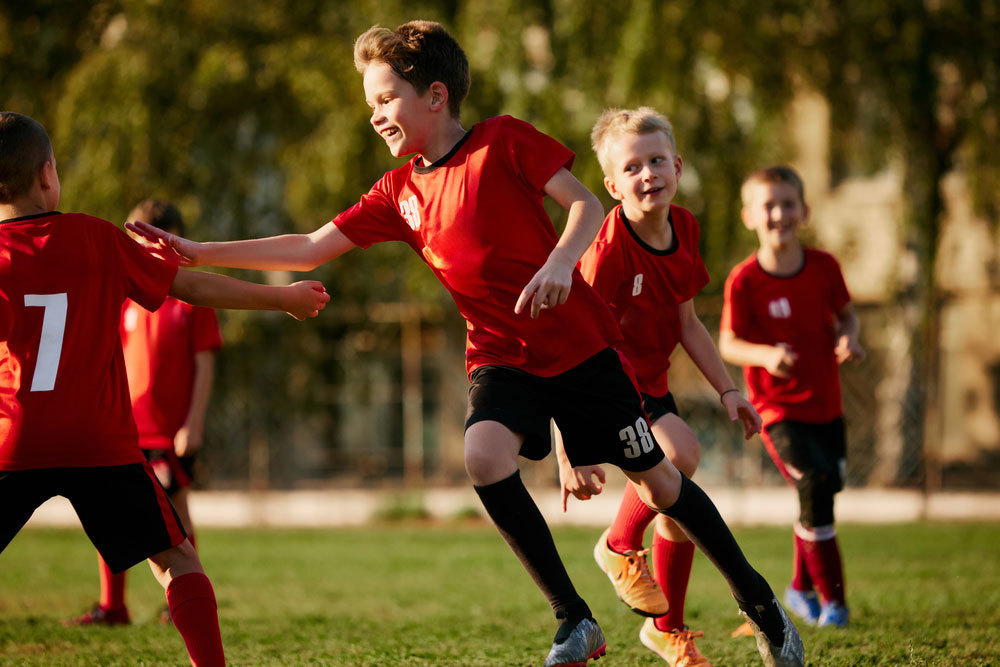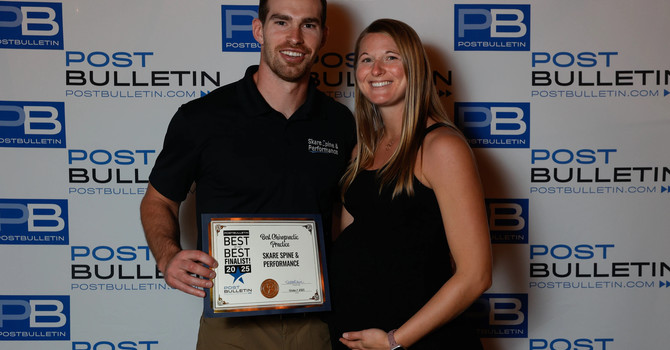
Fall sports are officially back! At Skare Spine & Performance, we offer comprehensive sports chiropractic to get your athlete back on the field or court.
We proudly help local athletes from Mayo, Century, John Marshall, Lourdes, Kingsland, Chatfield, Triton, Stewartville, St. Charles, Dover-Eyota, Pine Island, Byron, Fillmore-Central, Kasson-Mantorville, Zumbrota-Mazeppa, and Plainview-Elgin-Millvile.
Injuries happen in sports, and with the short seasons, injuries can result in significant missed time. At Skare Spine & Performance in Rochester, MN, we recognize the importance of keeping young athletes healthy and on their feet.
This comprehensive blog will delve into common fall sports injuries, the unique challenges young athletes face, and how chiropractic care can play a pivotal role in recovery and prevention.
The Landscape of Youth Sports Injuries
Youth sports participation has soared in recent years. With the year-round sports calendar and the demand placed on youth athletes, it's no wonder that there are over 3 million youth sports injuries per year.
While these injuries can range from minor sprains to more severe conditions, addressing them promptly is crucial to ensure proper healing and avoid long-term complications. As a former athlete with my fair share of injuries, I know the frustrations that athletes and parents go through when playing time is missed. That’s why we are dedicated to providing Rochester's best sports chiropractic care.
Common Fall Sports Injuries
Each fall sport presents its own set of injury risks. Let's take a closer look at some prevalent ones:
Football:
- Concussions: These head injuries can occur from multiple hits to the head or one significant blow. They can have serious consequences and require immediate medical attention.
- Sprains and strains: Due to football's physical nature, ankle sprains and muscle strains like hamstring pulls are common.
- Shoulder injuries: Impacts and tackles can lead to shoulder dislocations, AC joint separations, or rotator cuff injuries.
- Knee Injuries: Significant knee injuries like ACL, MCL, or meniscus tears are common in football.
Volleyball:
- Ankle sprains: Jumping and landing can stress the ankles significantly, making it the most common sports injury.
- Finger injuries: Jammed fingers or ligament sprains in the fingers are frequent occurrences.
- Shoulder pain: Repetitive overhead motions can lead to rotator cuff tendinitis or impingement.
- Low Back Pain: The repetitive twisting motion of the volleyball swing can strain the lower back.
- Jumper’s Knee: This injury is a stress reaction on the front of the knee, usually due to rapid growth spurts and repetitive jumping and running.
Soccer:
- Knee injuries: ACL tears and meniscus injuries can occur from sudden pivots or collisions.
- Ankle sprains: Quick changes in direction and uneven playing surfaces can lead to ankle sprains.
- Concussions: Heading the ball or accidental collisions can result in concussions.
- Patella Femoral Pain Syndrome: Typically presents with dull and achy pain anywhere around the knee due to high levels of running and cutting.
Cross Country:
- Shin splints: Overuse injury causing pain along the shinbone.
- Stress fractures: Tiny cracks in the bone caused by repetitive stress.
- Plantar fasciitis: Inflammation of the tissue connecting the heel bone to the toes, leading to heel pain.
- IT Band Pain: Often due to hip weakness, IT band pain can present with a burning sensation or pain outside the knee.
- Unique Challenges for Young Athletes
Due to their developing bodies and growth plates, young athletes are particularly susceptible to injuries. Additionally, they may be more prone to overuse injuries from specializing in one sport year-round or playing on multiple teams simultaneously.
How Skare Spine & Performance Can Help
At Skare Spine & Performance, we offer a multi-faceted approach to injury treatment and prevention for young athletes. We'll work closely with you and your athlete to:
- Accurately Diagnose the Injury: We utilize thorough assessments and diagnostic tools to pinpoint the exact cause of pain and dysfunction.
- Provide Effective Treatment: Our chiropractor employs a variety of techniques, including chiropractic adjustments, soft tissue therapy, and rehabilitative exercises, to promote healing, reduce pain, and restore function.
- Address Underlying Imbalances: We identify and correct musculoskeletal imbalances contributing to injuries.
- Improve Performance: We work to enhance strength, flexibility, and movement patterns to optimize athletic performance.
- Prevent Future Injuries: We educate young athletes and their parents on proper warm-up, cool-down, and injury prevention strategies.
Our Services for Youth Athletes:
- Chiropractic Adjustments: Gentle, targeted adjustments to improve the motion of your spine and joints, reduce pain, relax tight muscles, and improve nerve function.
- Soft Tissue Therapies: Hands-on techniques to release muscle tension, improve circulation, and reduce pain.
- Rehabilitation Exercises: Personalized exercise programs to strengthen muscles, improve flexibility, and restore proper movement patterns.
- Blood Flow Restriction Therapy: helps rehabilitate specific injured areas of the body by applying a tourniquet to the limb as low-load exercises are completed. This method creates a response that promotes strength and muscle building without the typical amount of physical pressure being applied to the affected joints and soft tissues.
- Dry Needling: Targeted dry needling can help release tight muscles and trigger points, improve blood flow, and kickstart healing.
- Sports Taping: Support and stabilize injured joints to promote healing and prevent further injury.
- Nutritional Counseling: Guidance on proper nutrition to fuel performance and support recovery.
In-Season Recovery Advice:
Many factors can contribute to injuries, but taking care of the small but important things off the field can prevent injuries and improve performance. Here are three critical factors:
#1: Sleep
Sleep is your best recovery tool. It is when our bodies repair itself. Weight training, conditioning, and practice create a stressful stimulus for the body, and when we sleep, our body adapts to that stimulus, so it is crucial to get adequate sleep. We want to aim for 7-9 hours of quality sleep per night.
Here are a few sleep tips:
- Try to have your room cool and dark.
- Create a bedtime routine every night to let your body know it’s time to sleep.
- Try to limit technology for at least 30 minutes each night before bed.
#2: Increase protein and good carbohydrates
Protein provides the building blocks for our muscles and tissues to repair themselves. Most people don’t consume enough protein, especially athletes in season. We want most of our protein from natural food sources like beef, chicken, fish, and eggs. Protein powders can be beneficial as long as they don’t contain many fillers and extra ingredients.
Increasing carbohydrates from good sources is important for muscle energy levels, especially during periods of high activity. Good sources of carbohydrates include sweet potatoes, fruit, and rice. We want to avoid processed sugary foods like candy, pop, chips, cereal, etc., as those provide little nutritional value. Getting carbohydrates from whole foods provides vitamins and nutrients and allows your body to process the carbohydrates more efficiently.
#3: Stay on top of hydration
Staying hydrated is also very important for staying healthy and increasing performance. Even 2% dehydration can lead to decreased physical performance and cognitive function.
Some baselines to follow:
- Aim to drink at least half your body weight in fluid ounces of water daily.
- A good equation to follow when exercising is:
- Half your body weight/30 = ounces of water every 15 minutes.
- So, if you weigh 150 pounds, you should drink the equivalent of 5 ounces of water every minute when exercising or practicing.
Electrolytes are also essential for hydration, especially if you are known for experiencing cramping. Electrolytes are important minerals like sodium, potassium, and magnesium. Many popular sports drinks provide electrolytes, but they also contain high amounts of sugar that your body uses to process the electrolytes, which makes them counterproductive. I love the LMNT packets for electrolytes, but you can also add sea salt or Himalayan salt to your food and water to get adequate electrolytes.
#4: Active and Passive Stretching
While static stretching, holding a stretch for a prolonged period, was once a warm-up staple, research now points towards active or dynamic stretching as the superior choice. Active stretching involves controlled movements that mimic the activity you're about to do, increasing blood flow and flexibility and preparing your muscles and joints for action. Static stretching, on the other hand, is best saved for cooling down after exercise, helping to relax muscles and improve overall flexibility. Try to hold the stretch for at least 60 seconds when static stretching, as this provides the best benefit to the muscle.
#5: Know Hurt Vs. Harm
One important concept to remember is that injuries will happen, but if they get better every day and within a few days, you are back to 100%. That is okay, and that’s what we consider “hurt.” If you don’t see significant improvement within a few days, that’s what we consider “harm,” and those are important to get treatment for and care for before they become a bigger issue. The fall sports season is short, so we want to ensure your favorite athlete can stay on the field!
Keep Your Young Athlete in the Game
Don't let injuries sideline your young athlete's season. At Skare Spine & Performance, we're committed to helping them stay healthy and active and reach their full potential.
If your child is experiencing pain or discomfort, don't wait. Schedule an appointment with us today, and let us help them return to the sport they love.

Darcy Sullivan
Contact Me



